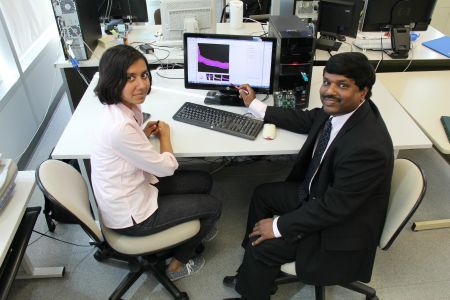
Department of Electrical and Computer Engineering professor Mrinal Mandal and Mitacs Globalink intern Suranjana Samanta review images of skin cancer cells in a tissue sample.
(Edmonton) Every year in Alberta, approximately one in three new cases of cancer will be diagnosed as skin cancer. Despite this, Alberta has a higher rate of intentional tanning and accidental sun-burning than any other province. An individual's risk of developing skin cancer doubles with every five sunburns, while tanning increases the risk of non-melanoma skin cancers regardless of skin type.
A U of A electrical and computer engineering professor who's conducting research to help health care professionals diagnose skin cancer is getting help through Mitacs, a national non-profit organization that connects Canadian researchers to industry and top-performing students from around the world.
One such student is Suranjana Samanta, an undergraduate electrical and computer engineering student from Jadavpur University in India. Since arriving in Canada in May, Samanta has been working with researchers at the Department of Electrical and Computer Engineering and the Cross Cancer Institute to develop a diagnostics system for early detection of melanoma skin cancer.
The project, led by ECE professor Mrinal Mandal, could help doctors and laboratory scientists to make faster, cheaper diagnoses that could potentially save lives. The all-in-one system would connect to a medical-laboratory computer via its USB drive and include specialized image processing software. The software can analyze an image of a patient's skin at the site of a suspected cancerous lesion and provide accurate diagnoses without invasive testing. Once complete, the tool could provide an important first step for diagnosis that could save laboratory resources and reduce time delays on testing results.
For Samanta, her Globalink internship has been an exciting and challenging first step into her future biomedical research career. "Every day I'm doing something wonderful. I came here for the world-class universities, excellent research, and cutting-edge industrial innovation. The reality of what it's like here has far surpassed my expectations."
Through the Mitacs Globalink internship program, 750 international students are conducting research at 45 Canadian universities this summer, an increase of 58 per cent over last year. Hailing from as far away as India, China, Brazil, Vietnam, France, Saudi Arabia, Turkey and Mexico, 55 of them are working under the direction of Canadian professors at the University of Alberta.
After nearly doubling its international student enrolment from 2004 to 2014, Canada is expected to double its enrolment base again by 2022 and currently sits at seventh overall as a popular destination for international students, says Alejandro Adem, Mitacs CEO and scientific director. He adds that the economic impact of having foreign talent choose to study here is estimated to be more than $8 billion.
"We're succeeding in helping to move Canada up in the rankings as a top research destination," Adem said. "Statistics show that Canada is now the first and only choice for roughly 80 per cent of international students seeking foreign placements, and that increases our chance of retaining them when go on to launch their careers."
Since 2009, Mitacs alone has matched well over 2,000 senior undergraduates with Canadian faculty through the Globalink program. Funded by the Government of Canada, Globalink now offers two-way mobility opportunities between Canada and Mitacs partner countries for both undergraduate and graduate students.